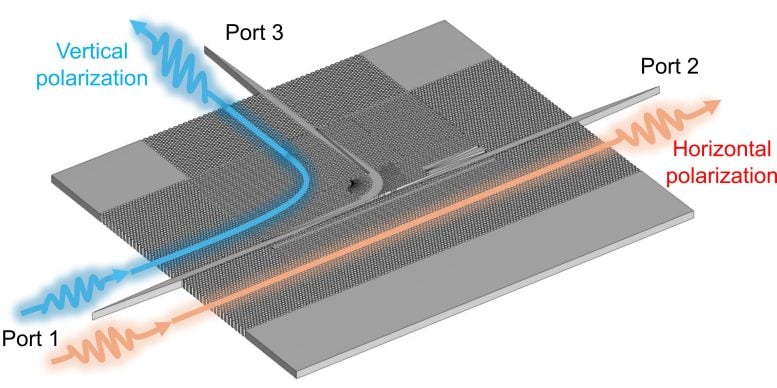

A group of researchers has developed a new polarization multiplexer, advancing the capabilities of 6G communications.
Terahertz communications mark a new frontier in wireless technology, offering data transmission speeds that significantly surpass those of existing systems.
By operating at terahertz frequencies, these systems can support unprecedented bandwidth, enabling ultra-fast wireless communication and data transfer. However, one of the significant challenges in terahertz communications is effectively managing and utilizing the available spectrum.
The team has developed the first integrated terahertz polarization (de)multiplexer implemented on a substrateless silicon base which they have successfully tested in the sub-terahertz J-band (220-330 GHz) for 6G communications and beyond.
The University of Adelaide’s Professor Withawat Withayachumnankul from the School of Electrical and Mechanical Engineering led the team which also includes a former PhD student at the University of Adelaide, Weijie Gao, who is now a postdoctoral researcher working alongside Professor Masayuki Fujita at Osaka University.
Video demonstration of simultaneous two-channel communications with orthogonal polarizations. Credit: 2024 Gao et al., Ultra-wideband terahertz integrated polarization multiplexer. Laser & Photonics Reviews
“Our proposed polarization multiplexer will allow multiple data streams to be transmitted simultaneously over the same frequency band, effectively doubling the data capacity,” said Professor Withayachumnankul.
“This large relative bandwidth is a record for any integrated multiplexers found in any frequency range. If it were to be scaled to the center frequency of the optical communications bands, such a bandwidth could cover all the optical communications bands.”
Enhancing Communication Efficiency
A multiplexer makes it possible for several input signals to share one device or resource – such as the data of several phone calls being carried on a single wire.
The new device that the team has developed can double the communication capacity under the same bandwidth with lower data loss than existing devices. It is made using standard fabrication processes enabling cost-effective large-scale production.

“This innovation not only enhances the efficiency of terahertz communication systems but also paves the way for more robust and reliable high-speed wireless networks,” said Dr. Gao.
“As a result, the polarisation multiplexer is a key enabler in realizing the full potential of terahertz communications, driving forward advancements in various fields such as high-definition video streaming, augmented reality, and next-generation mobile networks such as 6G.”
Paving the Way for Future Developments
The groundbreaking challenges addressed in the team’s work, which they have published in the Laser & Photonics Reviews significantly advance the practicality of photonics-enabled terahertz technologies.
“By overcoming key technical barriers, this innovation is poised to catalyze a surge of interest and research activity in the field,” said Professor Fujita who is a co-author of the paper.
“We anticipate that within the next one to two years, researchers will begin to explore new applications and refine the technology.”
Over the following three to five years, the team expects to see significant advancements in high-speed communications, leading to commercial prototypes and early-stage products.
“Within a decade, we foresee widespread adoption and integration of these terahertz technologies across various industries, revolutionizing fields such as telecommunications, imaging, radar, and the Internet of Things,” said Professor Withayachumnankul.
This latest polarization multiplexer can be seamlessly integrated with the team’s earlier beamforming devices on the same platform to achieve advanced communications functions. The studies into these were previously published in the journals Optica and APL Photonics.
Reference: “Ultra-Wideband Terahertz Integrated Polarization Multiplexer” by Weijie Gao, Masayuki Fujita, Shuichi Murakami, Tadao Nagatsuma, Christophe Fumeaux and Withawat Withayachumnankul, 29 August 2024, Laser & Photonics Reviews.
DOI: 10.1002/lpor.202400270
The study was funded by the Japan Science and Technology Agency, the National Institute of Information and Communications Technology, and the Australian Research Council.